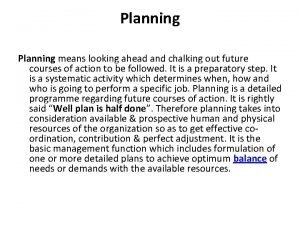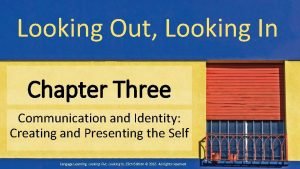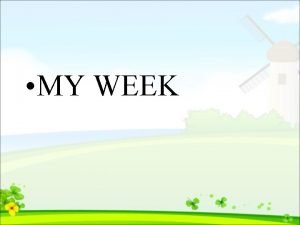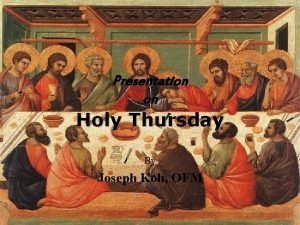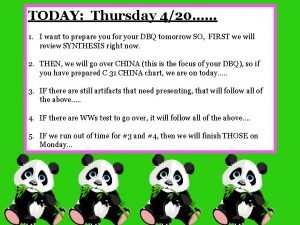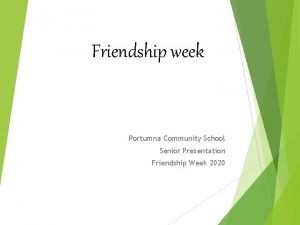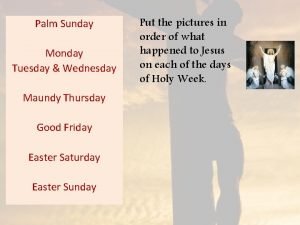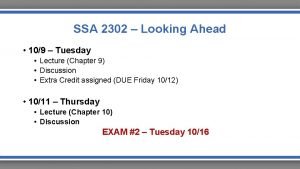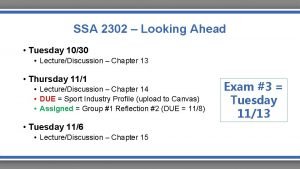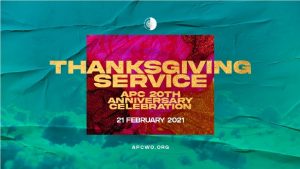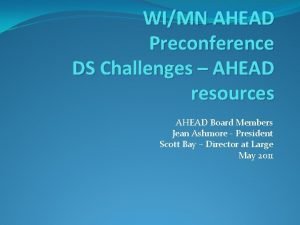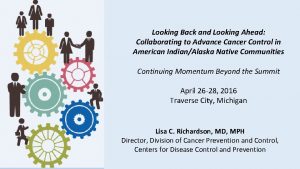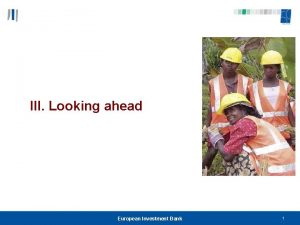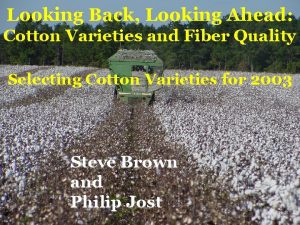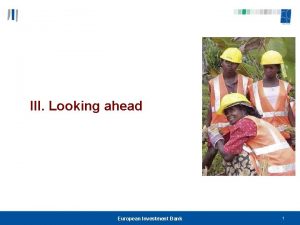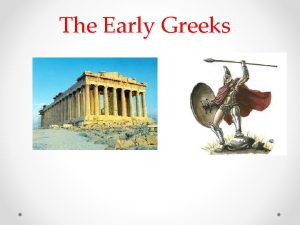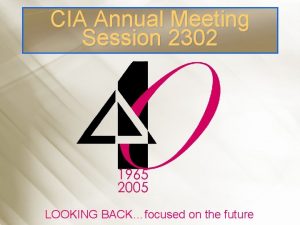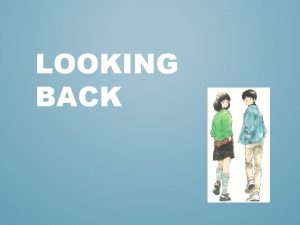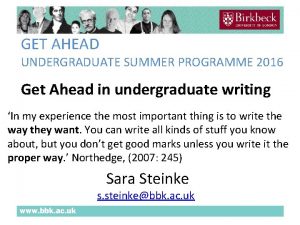SSA 2302 Looking Ahead Thursday 913 Lecture Discussion

























- Slides: 25

SSA 2302 – Looking Ahead • Thursday 9/13 • Lecture & Discussion (Chapter 4) • GROUP 1 Reflection Assigned (DUE 9/18) • Tuesday 9/18 • Lecture & Discussion (Chapter 5) • Industry Profile assigned (DUE 11/1) • Thursday 9/20 • Exam #1 • Electronic – Meet in Imholte 11 (computer lab)

CHAPTER 4 Management Concepts and Practice in Sport Organizations Kathy Babiak, Kathryn Heinze, and Lucie Thibault

Groups for today 1. Jocelyn, Blake, Zach 2. Elli, Chase, Cooper 3. Joe B. , Dean, Megan 4. J. D. , Brandon, Josh 5. Sheri, Jordan, Nora 6. Nikki, Joe P. , Jake

Organization • Defined: A social entity created to coordinate the efforts of individuals with the intent to achieve goals • Sport example (figure 4. 1, organizational chart of a professional baseball team) • By working in a collective, organizations can achieve • Economies of scale: savings originating from the mass production of goods and services (increasing the scale of operations) • Economies of scope: maximization of resources used throughout an organization (having a variety of products and services that can reach a broadened base)

Organization Process by which sport organizations achieve goals: inputs → transformation → outputs Financial Human resources Raw materials Expertise/knowledg e Through technology (machinery; digital platforms); Skills of employees Goods and services sought by consumers

Types of Sport Organizations • Public organizations • Federal, state, and local government agencies • Nonprofit organizations • Volunteer/voluntary organizations • Commercial organizations • Main goal is to make a profit What are real-world examples of these? Sport Industry Sectors Model

Organizational Environment • Dealing with sport organization environments including: • devising strategies • using technology • exerting power • Role of stakeholders in addressing an organization’s environment • Stakeholders: individuals or groups that can affect or be affected by the organization or business • Primary: engage in economic exchanges with the organization • Secondary: those who affect or are affected by the actions of the org.

Organizational Environment • Environment: all elements outside the organization’s boundary that could potentially affect all or part of the organization • Two organizational environment categories: • General: • May not have a direct effect on the day-to-day operations • Economic conditions; Technology; Political climate; Social/cultural forces • Specific: • Task-oriented • Includes stakeholders

General Environment Elements • The economy • Fan consumption during a recession? • Technology • Fan engagement; Business communications/operations • Politics • Policy, law, legislation, foreign relations • Social and cultural forces • Social climate; Cultural influences • Demography • Gender, age, education level, etc.

Elements of the Specific Environment • Questions to ask about elements of the specific environment • • Who are the consumers and what are their preferences? Who are the suppliers? Who is the competition? What role does the government play in the environment?

Minnesota Vikings • What are examples of their general and specific environments? • Who would we consider their primary and secondary stakeholders? • Choose one general environment element and discuss how the Vikings’ organization may impact or be impacted by this?

Organizational Effectiveness • Effectiveness: • the extent to which goals are achieved (focus on results) • Efficiency: • the achievement of goals using minimum resources (focus on activities)

Strategy • Plans to cope with environment • Steps in the development of plans • Organizational processes involved in developing a strategy to gain competitive advantage • Development of partnerships and alliances • Motives for the creation of organizational partnerships • Studies that have examined strategies and alliances in sport organizations (continued)

Organizational Strategy Plans 1. Identify goals, objectives, and the mission of the organization – must be congruent with mission 2. Determine strategic objectives – assessing what the org. wants to achieve; analysis 3. Identify required resources – need adequate/appropriate resources 4. Establish a timeline for implementing a strategy – implement, measure milestones

Organizational Culture • Organizational Culture: a pattern of basic assumptions that are invented, discovered, or developed by a given group as it learns to cope with its problems of external adaptation and internal integration • Pattern of basic assumptions • • • Stories and myths Symbols Language Ceremonies and rites Physical setting Symbolic artifacts How do you think these represented regarding the Vikings culture?

Dimensions of Organizational Structure • Organizational Structure: identifies the formal reporting lines amongst individuals and organizational units; determines the grouping of functions, and departments, and provides designs that enhance communication, coordination, and integration of the work to be achieved within the org. 1. Division of labor; Specialization • Vertical – number of levels, more = more complex • Horizontal – number of units across the org • Spatial – number of geographical locations in which an organization operates

Dimensions of Organizational Structure 2. Standardization/Formalization: documentation that controls employee behavior and activities 3. Centralization: hierarchical level that has authority to make decisions Centralized = top of hierarchy make decisions Decentralized = decision-making is delegated throughout the organization

Dimensions of Organizational Structure Factors affecting centralized or decentralized decisions • Cost: greater the cost = more centralized • Timing: greater the urgency = more centralized • Qualifications of employees: greater the number of qualified employees = more decentralized • Relationships among the dimensions of organizational structure

Organizational Design • Based on interplay of five organizational parts 1. Top management 2. Middle management 3. Technical core 4. Administrative support staff 5. Technical support staff

Organizational Size • Size affects organizational structure • • • Number of employees Number of organizational locations Value of organizational assets Sales volume Number of clients

Org. Change - Organizational Life Cycle • Also called the model of organizational growth • Stages of growth – Do we see this in sports teams? • Entrepreneurial – the vision • Collectivity – leadership established; develop clear goals • Formalization – rules and procedures are developed • Elaboration – collaboration and teamwork; address revitalization if needed

Org. Change - Contextualist Approach • Change does not take place in isolation or in a brief period • Change is accomplished over time by considering three elements 1. Content 2. Context 3. Process

Org. Change - Innovation • Product innovations • Creation of new product designs • Development of new products • Process innovations • Improve efficiency or effectiveness of organizational processes

Social Media and Management Concepts • Social media has the potential to advance organizational performance (effectiveness) and processes (efficiency) • Use of social media in organizations may influence and alter • Knowledge sharing • Socialization • Power processes • How are the Vikings doing this?

Practical Application • Critical thinking in sport organizations • Solve problems • Make informed decisions • Develop comprehensive plans • Ethics and the sport organization • Corporate social responsibility
 Planning is looking
Planning is looking Sq 913
Sq 913 Framework decision 2008/913/jha
Framework decision 2008/913/jha Sqtor
Sqtor Looking out looking in chapter 9
Looking out looking in chapter 9 Identity management looking out looking in
Identity management looking out looking in 01:640:244 lecture notes - lecture 15: plat, idah, farad
01:640:244 lecture notes - lecture 15: plat, idah, farad Discussion of simple distillation
Discussion of simple distillation Saturday sunday monday tuesday wednesday thursday friday
Saturday sunday monday tuesday wednesday thursday friday Blessed holy thursday
Blessed holy thursday Thursday bell ringers
Thursday bell ringers Happy easter traditions
Happy easter traditions Thursday
Thursday My favorite subject is english because
My favorite subject is english because Monday tuesday wednesday thursday friday calendar
Monday tuesday wednesday thursday friday calendar Thursday 420
Thursday 420 Thursday bell ringers
Thursday bell ringers This coming thursday
This coming thursday Holy thursday cartoon
Holy thursday cartoon Senior g friendship thursday
Senior g friendship thursday Wednesday bellringer
Wednesday bellringer Which festival celebrates christs rising from death
Which festival celebrates christs rising from death Sunday monday tuesday wednesday
Sunday monday tuesday wednesday Adjectives for tuesday
Adjectives for tuesday St paul's church wibsey
St paul's church wibsey Dua imam zainul abideen
Dua imam zainul abideen
